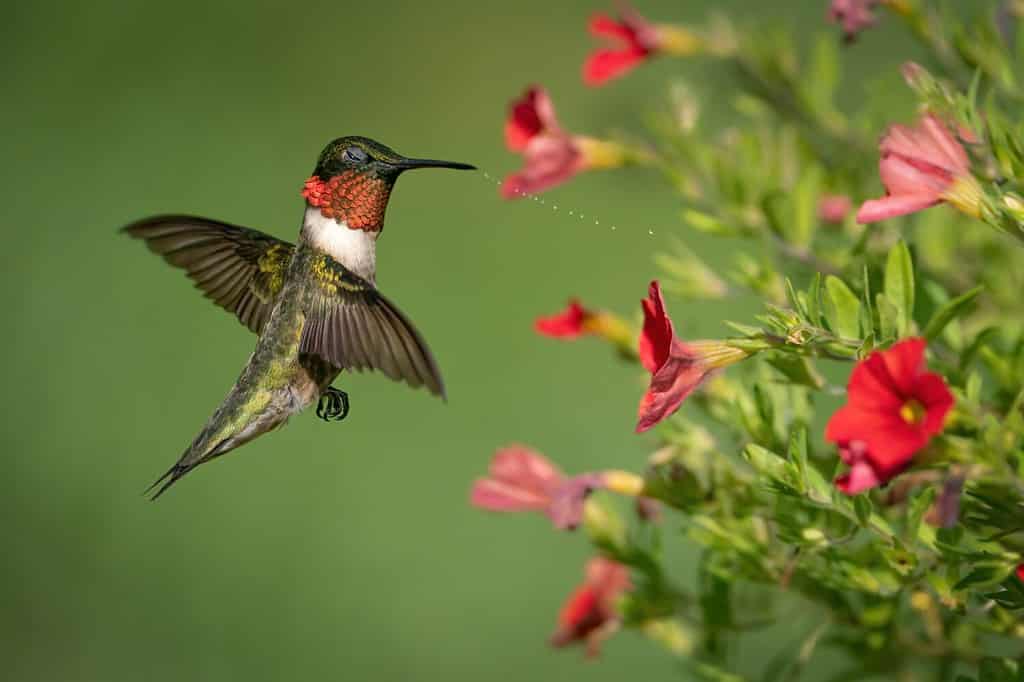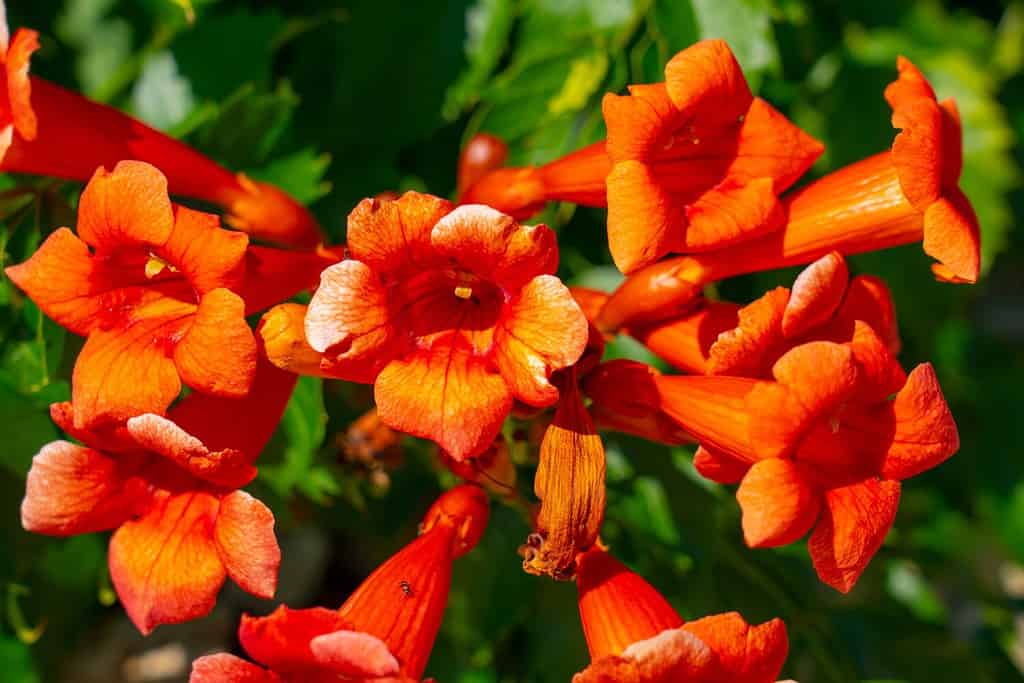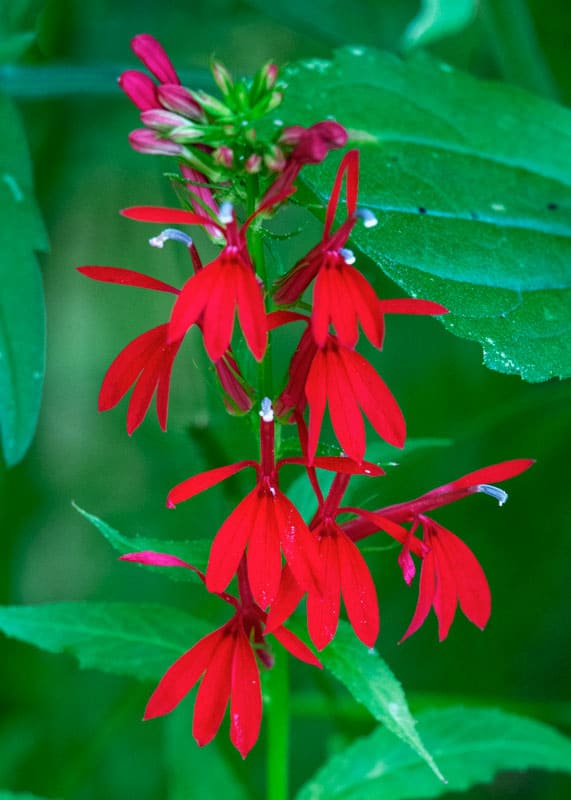Hummingbirds have captivated humans for centuries. They’re very easy to identify thanks to their iridescent feathers and fast-moving wings. These small, vibrant creatures are a sight to behold, and the odds are pretty good that you’ve spotted one or two in New Jersey.
One of the most intriguing aspects of hummingbirds is their migratory behavior, a phenomenon that adds a layer of mystery and awe to their already mesmerizing presence. These birds travel thousands of miles when they migrate in the winter.
The vast majority of hummingbirds leave New Jersey as the weather cools. In this article, we’ll discuss when hummingbirds are set to flee New Jersey, as well as where they go.
When Hummingbirds Are Set to Flee New Jersey

The
ruby-throated hummingbird
is a common migratory species in New Jersey.
©Cavan-Images/Shutterstock.com
Hummingbirds, particularly those in New Jersey, are guided by a delicate balance of natural cues when deciding the right time to embark on their migratory journey. We don’t know exactly what tells birds when it is time to leave, as migration is something that’s very difficult to study.
However, we believe that the light level mostly determines it. When the seasons change to fall, the days get much shorter. This signals to the bird that it is time to leave.
Mostly, hummingbirds leave in the early fall months from late August through September. Different individuals may leave sooner or later, though. It’s best to leave up your feeders for a bit past the time they typically leave to ensure there aren’t any stragglers.
Migration Routes and Destinations
When the hummingbirds migrate, they have to go somewhere. We didn’t know where they went; they were too small for tracking equipment. However, things have gotten smaller, allowing us to study migration more.
These avian travelers traverse the Eastern Seaboard and may journey southward through Florida and along the Gulf Coast, eventually reaching their wintering grounds in Central America and parts of Mexico. Here, flowers are available all year around, allowing them to survive through the colder winter.
These birds travel thousands of miles when they migrate, which is truly a feat that we’re still struggling to understand.
Species that Migrate and Species that Stay
While the vast majority of these species migrate, some of them are “resident” species. This term means that the species doesn’t migrate (at least, not much).
The Rufous Hummingbird can be spotted in New Jersey. This species is a bit strange because the birds migrate and don’t migrate. It all depends on the individual. The birds may migrate but not go very far, as well. They may only travel over one state, or they may travel over 3,000 miles.
The Red-throated Hummingbird is one of the most common species in New Jersey and absolutely migrates. When people think of hummingbirds, this is the species they often imagine. They overwinter in Central America.
While many hummingbirds leave New Jersey for winter retreats, some species remain year-round residents. The Anna’s Hummingbird, though not native to the East Coast, has been expanding its range and can now be spotted in New Jersey during the colder months.
The Costa’s Hummingbird may also stick around if the weather conditions are suitable.
Factors Influencing Migration

Hummingbirds absolutely adore trumpet vines, which provide them with plenty of food.
©martin.dlugo/Shutterstock.com
The timing of hummingbird migration is closely linked to environmental cues that signal the changing of seasons. As the days shorten and temperatures drop, these cues prompt hummingbirds to prepare for their arduous journey.
They will feed frantically in the weeks leading up to their migration. They have to save up calories for the trip, so you may see them more suddenly towards the end of summer – before they disappear.
As the food sources become scarcer, hummingbirds know it is time to leave. They will often depart just before the weather really begins to cool.
Migration is an evolutionary feat for hummingbirds, and it seems that its a behavior the vast majority of hummingbirds have developed. By migrating during the cold winter, the hummingbirds can feed through the winter and increase their chance of survival.
Different species have slightly different migratory behaviors, though. This difference is why the Ruby-throated hummingbirds always migrate and why the migration of the Rufous hummingbird migration is a bit complicated.
Tracking and Studying Hummingbird Migration

Scientists are just now starting to understand hummingbird migration
©rck_953/Shutterstock.com
Studying hummingbirds has historically been very difficult. Tracking devices and cameras were very large for a long time, and hummingbirds are considerably small. Therefore, it was only recently that scientists could use lightweight bands to track when hummingbirds are set to flee New Jersey.
Citizen science plays a huge role in the study of hummingbirds. Many bird enthusiasts will report bird sightings, which allows scientists to study when different species go where.
Radio telemetry allows researchers to follow individual birds in real-time, providing insights into their daily movements and behaviors. Scientists also use GPS tracking to determine where hummingbirds go and collect information on stopover locations.
Because of these advances, we know much more about hummingbird migrations than we knew only a decade ago.
Environmental Impacts on Hummingbird Migration

The cardinal flower is fairly popular in New Jersey, and hummingbirds like it, too.
©iStock.com/Jen Tepp
Hummingbirds in New Jersey rely on flowers for food. Native plants in New Jersey help support the population. So, if these flowers start to die sooner, the hummingbirds must leave sooner.
Native plants like bee balm, cardinal flower, and trumpet vine are not only aesthetically pleasing but also provide the necessary sustenance for these delicate travelers. You must also think about hummingbirds living north of New Jersey that must travel through it. They also require food.
By cultivating gardens and allowing native flowers to grow, you can help support the local population and the traveling hummingbirds.
Habitat loss and fragmentation can disrupt the migration of hummingbirds in New Jersey. While New Jersey has done well with conserving hummingbird habitats, food sources have still been disrupted.
Conserving Hummingbird Migration
Protecting stopover sites is essential for the survival of migrating hummingbirds. These locations provide crucial rest and refueling opportunities during their arduous journey. It is not only about where the hummingbird usually lives. The locations they stop while migrating are also vital for their survival.
For this reason, scientists have been working hard to understand where the hummingbirds in New Jersey go while migrating.
Public education plays a huge role in protecting migration routes. Often, it isn’t the huge changes that affect hummingbirds. Because they rely on flowers, it’s often the choice of suburban and urban residents that affects them, too. For instance, letting a small patch of hummingbird-safe flowers grow in your yard can help hummingbirds locally and those passing through.
Next time you’re landscaping, consider adding some flowers that hummingbirds can use.
Summary of When Hummingbirds are Set to Flee New Jersey
The annual departure of hummingbirds in New Jersey is a testament to the marvels these small birds are capable of. These tiny birds travel thousands of miles from one continent to another – often flying over huge bodies of water for hours.
We’re still learning a lot about migration timing, destinations, and routes. We know that hummingbirds must stop many times on their journey to refuel, but we’re still learning where they choose.
Hummingbird migration is a great example of how we often know less than we think. Humans didn’t even discover birds migrated until a couple of hundred years ago (before that, it was a popular theory that they dug holes in the ground and hibernated).
Hopefully, we’ll learn more about hummingbird migration in New Jersey over the next few years and find out exactly where these birds go after August.
The photo featured at the top of this post is © Birdiegal/Shutterstock.com
Thank you for reading! Have some feedback for us? Contact the AZ Animals editorial team.






